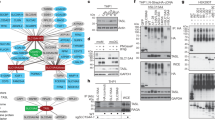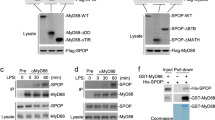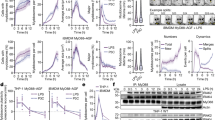Abstract
Recognition of pathogens by Toll-like receptors (TLRs) triggers innate immune responses through signaling pathways mediated by Toll–interleukin 1 receptor (TIR) domain–containing adaptors such as MyD88, TIRAP and TRIF. MyD88 is a common adaptor that is essential for proinflammatory cytokine production, whereas TRIF mediates the MyD88-independent pathway from TLR3 and TLR4. Here we have identified a fourth TIR domain–containing adaptor, TRIF-related adaptor molecule (TRAM), and analyzed its physiological function by gene targeting. TRAM-deficient mice showed defects in cytokine production in response to the TLR4 ligand, but not to other TLR ligands. TLR4- but not TLR3-mediated MyD88-independent interferon-β production and activation of signaling cascades were abolished in TRAM-deficient cells. Thus, TRAM provides specificity for the MyD88-independent component of TLR4 signaling.
This is a preview of subscription content, access via your institution
Access options
Subscribe to this journal
Receive 12 print issues and online access
$209.00 per year
only $17.42 per issue
Buy this article
- Purchase on SpringerLink
- Instant access to full article PDF
Prices may be subject to local taxes which are calculated during checkout






Similar content being viewed by others
Accession codes
References
Takeda, K., Kaisho, T. & Akira, S. Toll-like receptors. Annu. Rev. Immunol. 21, 335–376 (2003).
Janeway, C.A. Jr. & Medzhitov, R. Innate immune recognition. Annu. Rev. Immunol. 20, 197–216 (2002).
Takeuchi, O. et al. Cutting edge: role of Toll-like receptor 1 in mediating immune response to microbial lipoproteins. J. Immunol. 169, 10–14 (2002).
Alexopoulou, L. et al. Hyporesponsiveness to vaccination with Borrelia burgdorferi OspA in humans and in TLR1- and TLR2-deficient mice. Nat. Med. 8, 878–884 (2002).
Takeuchi, O. et al. Differential roles of TLR2 and TLR4 in recognition of gram-negative and gram-positive bacterial cell wall components. Immunity 11, 443–51 (1999).
Alexopoulou, L., Holt, A.C., Medzhitov, R. & Flavell, R.A. Recognition of double-stranded RNA and activation of NF-κB by Toll-like receptor 3. Nature 413, 732–738 (2001).
Hoshino, K. et al. Cutting edge: Toll-like receptor 4 (TLR4)-deficient mice are hyporesponsive to lipopolysaccharide: evidence for TLR4 as the Lps gene product. J. Immunol. 162, 3749–3752 (1999).
Poltorak, A. et al. Defective LPS signaling in C3H/HeJ and C57BL/10ScCr mice: mutations in Tlr4 gene. Science 282, 2085–2088 (1998).
Hayashi, F. et al. The innate immune response to bacterial flagellin is mediated by Toll-like receptor 5. Nature 410, 1099–1103 (2001).
Takeuchi, O. et al. Discrimination of bacterial lipoproteins by Toll-like receptor 6. Int. Immunol. 13, 933–940 (2001).
Hemmi, H. et al. Small anti-viral compounds activate immune cells via the TLR7 MyD88-dependent signaling pathway. Nat. Immunol. 3, 196–200 (2002).
Hemmi, H. et al. A Toll-like receptor recognizes bacterial DNA. Nature 408, 740–745 (2000).
Wesche, H., Henzel, W.J., Shillinglaw, W., Li, S. & Cao, Z. MyD88: an adapter that recruits IRAK to the IL-1 receptor complex. Immunity 7, 837–847 (1997).
Janssens, S. & Beyaert, R. Functional diversity and regulation of different interleukin-1 receptor-associated kinase (IRAK) family members. Mol. Cell. 11, 293–302 (2003).
Adachi, O. et al. Targeted disruption of the MyD88 gene results in loss of IL-1- and IL-18-mediated function. Immunity 9, 143–150 (1998).
Kawai, T., Adachi, O., Ogawa, T., Takeda, K. & Akira, S. Unresponsiveness of MyD88-deficient mice to endotoxin. Immunity 11, 115–122 (1999).
Kawai, T. et al. Lipopolysaccharide stimulates the MyD88-independent pathway and results in activation of IFN-regulatory factor 3 and the expression of a subset of lipopolysaccharide-inducible genes. J. Immunol. 167, 5887–5894 (2001).
Kaisho, T., Takeuchi, O., Kawai, T., Hoshino, K. & Akira, S. Endotoxin-induced maturation of MyD88-deficient dendritic cells. J. Immunol. 166, 5688–5694 (2001).
Horng, T., Barton, G.M. & Medzhitov, R. TIRAP: an adapter molecule in the Toll signaling pathway. Nat. Immunol. 2, 835–841 (2001).
Fitzgerald, K.A. et al. Mal (MyD88-adapter-like) is required for Toll-like receptor-4 signal transduction. Nature 413, 78–83 (2001).
Yamamoto, M. et al. Essential role for TIRAP in activation of the signalling cascade shared by TLR2 and TLR4. Nature 420, 324–329 (2002).
Horng, T., Barton, G.M., Flavell, R.A. & Medzhitov, R. The adaptor molecule TIRAP provides signalling specificity for Toll-like receptors. Nature 420, 329–333 (2002).
Yamamoto, M. et al. Cutting edge: a novel Toll/IL-1 receptor domain-containing adapter that preferentially activates the IFN-β promoter in the Toll-like receptor signaling. J. Immunol. 169, 6668–6672 (2002).
Oshiumi, H., Matsumoto, M., Funami, K., Akazawa, T. & Seya, T. TICAM-1, an adaptor molecule that participates in Toll-like receptor 3-mediated interferon-β induction. Nat. Immunol. 4, 161–167 (2003).
Yamamoto, M. et al. Role of adaptor TRIF in the MyD88-independent Toll-like receptor signaling pathway. Science 301, 640–643 (2003).
Hoebe, K. et al. Identification of Lps2 as a key transducer of MyD88-independent TIR signalling. Nature 424, 743–748 (2003).
Sharma, S. et al. Triggering the interferon antiviral response through an IKK-related pathway. Science 300, 1148–1151 (2003).
Fitzgerald, K.A. et al. IKKε and TBK1 are essential components of the IRF3 signaling pathway. Nat. Immunol. 4, 491–496 (2003).
Mink, M., Fogelgren, B., Olszewski, K., Maroy, P. & Csiszar, K. A novel human gene (SARM) at chromosome 17q11 encodes a protein with a SAM motif and structural similarity to Armadillo/β-catenin that is conserved in mouse, Drosophila, and Caenorhabditis elegans. Genomics 74, 234–244 (2001).
O'Neill, L.A., Fitzgerald, K.A. & Bowie, A.G. The Toll-IL-1 receptor adaptor family grows to five members. Trends. Immunol. 24, 286–290 (2003).
Bin, L.H., Xu, L.G. & Shu, H.B. TIRP, a novel Toll/interleukin-1 receptor (TIR) domain-containing adapter protein involved in TIR signaling. J. Biol. Chem. 278, 24526–24532 (2003).
Kopydlowski, K.M. et al. Regulation of macrophage chemokine expression by lipopolysaccharide in vitro and in vivo. J. Immunol. 163, 1537–1544 (1999).
Ohmori, Y. & Hamilton, T.A. Requirement for STAT-1 in LPS-induced gene expression in macrophages. J. Leukoc. Biol. 69, 598–604 (2001).
Toshchakov, V. et al. TLR4, but not TLR2, mediates IFN-beta-induced STAT-1α/β-dependent gene expression in macrophages. Nat. Immunol. 3, 392–398 (2002).
Doyle, S. et al. IRF3 mediates a TLR3/TLR4-specific antiviral gene program. Immunity 17, 251–263 (2002).
Sakaguchi, S. et al. Essential role of IRF-3 in lipopolysaccharide-induced interferon-beta gene expression and endotoxin shock. Biochem. Biophys. Res. Commun. 306, 860–866 (2003).
Hacker, H. et al. Immune cell activation by bacterial CpG-DNA through myeloid differentiation marker 88 and tumor necrosis factor receptor-associated factor (TRAF)6. J. Exp. Med. 192, 595–600 (2000).
Schnare, M., Holt, A.C., Takeda, K., Akira, S. & Medzhitov, R. Recognition of CpG DNA is mediated by signaling pathways dependent on the adaptor protein MyD88. Curr. Biol. 10, 1139–1142 (2000).
Vasilakos, J.P. et al. Adjuvant activities of immune response modifier R-848: comparison with CpG ODN. Cell Immunol. 204, 64–74 (2000).
Grosshans, J., Schnorrer, F. & Nusslein-Volhard, C. Oligomerisation of Tube and Pelle leads to nuclear localisation of dorsal. Mech. Dev. 81, 127–38 (1999).
Jiang, Z. et al. Pellino 1 is required for interleukin-1 (IL-1)-mediated signaling through its interaction with the IL-1 receptor-associated kinase 4 (IRAK4)-IRAK-tumor necrosis factor receptor-associated factor 6 (TRAF6) complex. J. Biol. Chem. 278, 10952–10956 (2003).
Yu, K.Y. et al. Cutting edge: mouse pellino-2 modulates IL-1 and lipopolysaccharide signaling. J. Immunol. 169, 4075–4078 (2002).
Jensen, L.E. & Whitehead, A.S. Pellino2 activates the mitogen activated protein kinase pathway. FEBS Lett. 545, 199–202 (2003).
Jensen, L.E. & Whitehead, A.S. Pellino3, a novel member of the Pellino protein family, promotes activation of c-Jun and Elk-1 and may act as a scaffolding protein. J. Immunol. 171, 1500–1506 (2003).
Sato, M. et al. Distinct and essential roles of transcription factors IRF-3 and IRF-7 in response to viruses for IFN-α/β gene induction. Immunity 13, 539–548 (2000).
Sato, S. et al. A variety of microbial components induce tolerance to lipopolysaccharide by differentially affecting MyD88-dependent and -independent pathways. Int. Immunol. 14, 783–791 (2002).
Acknowledgements
We thank D. Golenbock and H. Tomizawa for providing the NF-κB reporter plasmid and R-848, respectively. We also thank T. Kawai, H. Sanjo and H. Kuwata for discussions; M. Hashimoto for secretarial assistance; N. Okita and N. Iwami for technical assistance; and P. Lee for critical reading of the manuscript. Supported by grants from Special Coordination Funds; the Ministry of Education, Culture, Sports, Science and Technology; Research Fellowships of the Japan Society for the Promotion of Science for Young Scientists; The Uehara Memorial Foundation; The Naito Foundation; and The Junior Research Associate from RIKEN.
Author information
Authors and Affiliations
Corresponding author
Ethics declarations
Competing interests
The authors declare no competing financial interests.
Supplementary information
Supplementary Fig. 1.
Anti-mTRAM specifically recognized mouse TRAM and human TRAM 293 cells were transfected with empty (5 μg), mTRAM (1 μg), hTRAM (1 μg), and MyD88 (5 μg) vectors. The total amount of DNA (5 μg) was kept constant by adding the empty vector. Cell lysates were immunoprecipitated (IP) with anti-Myc (9B11, Cell signaling), and immunoblotted (IB) with anti-mTRAM or anti-Myc (9E10, Santa Cruz). (PDF 128 kb)
Rights and permissions
About this article
Cite this article
Yamamoto, M., Sato, S., Hemmi, H. et al. TRAM is specifically involved in the Toll-like receptor 4–mediated MyD88-independent signaling pathway. Nat Immunol 4, 1144–1150 (2003). https://doi.org/10.1038/ni986
Received:
Accepted:
Published:
Issue Date:
DOI: https://doi.org/10.1038/ni986
This article is cited by
-
IKKε and TBK1 prevent RIPK1 dependent and independent inflammation
Nature Communications (2024)
-
IFNγ modulates the innate immune response via Toll-like receptors in green-spotted pufferfish (Tetraodon nigroviridis)
Aquaculture International (2024)
-
Flotillins affect LPS-induced TLR4 signaling by modulating the trafficking and abundance of CD14
Cellular and Molecular Life Sciences (2024)
-
Scavenger receptor B1 facilitates the endocytosis of Escherichia coli via TLR4 signaling in mammary gland infection
Cell Communication and Signaling (2023)
-
Analysis of chicken macrophage functions and gene expressions following infectious bronchitis virus M41 infection
Veterinary Research (2021)



